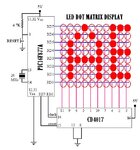congthegreat21
Newbie level 3

Re: A zuisti's PIC16 MMD program, now in MikroC too
sir zuisti, i have an available pic but not same as what you are using, what part of the program am i going to change if i use pic16f877a instead of pic16f628a?
thank you sir
sir zuisti, i have an available pic but not same as what you are using, what part of the program am i going to change if i use pic16f877a instead of pic16f628a?
thank you sir










